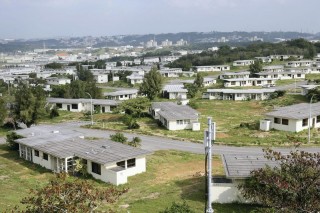Loading
Search
▼ Use of Returned U.S. Sites Vital to Okinawa Economy
- Category:Event
Monday marked the 45th anniversary of Okinawa Prefecture’s return to Japanese sovereignty in 1972.
An increasing number of facilities previously used exclusively by U.S. forces are being returned, shrinking U.S. holdings by almost 10,000 hectares. However, 70.6 percent of all such facilities in Japan remain concentrated in the prefecture.
The Okinawa economy is nevertheless thriving, with a record number of tourists. Key issues for the prefecture will likely be not only easing the burden of U.S. bases, but also how to effectively utilize returned former military sites for economic growth.
The total area of facilities exclusively used by U.S. forces in Okinawa was about 28,000 hectares as of May 1972 when the prefecture was returned to Japan. About 4,000 hectares of the Northern Training Area — which straddles the villages of Kunigami and Higashi — was returned to Japan in December last year. This reduced the area of such facilities in the prefecture to 8 percent of the prefecture’s land, or about 18,600 hectares, as of January this year.
There has been progress in utilizing former U.S. military sites that have been returned. About 192 hectares of Naha’s Shintoshin district — once a residential area for U.S. forces — was returned by 1987. Parks and large-scale commercial centers have been constructed there, and condominiums are also going up. The Okinawa prefectural government estimates the direct economic impact of the return to be ¥163.4 billion annually.
The University of the Ryukyus’ Faculty of Medicine and the university hospital will be relocated by fiscal 2024 to a 51-hectare area in Ginowan in the prefecture. Formerly known as the West Futenma Housing Area of the U.S. Marine Corps’ Camp Foster, the lot was returned in 2015. The Cabinet Office plans to construct a health and medical hub at the site.
In April, bank protection work was started to surround a planned landfill site on the coast of the Henoko district in Nago, in preparation for relocation of the 480-hectare Futenma Air Station in Ginowan to Henoko and the ensuing return of the Futenma base.
The prefectural government estimates the economic impact of Futenma’s return to be ¥386.6 billion. Even so, it remains to be seen whether the return will proceed as smoothly as planned by the central government, in light of its deepening row with the prefectural government.
Tourist numbers in Okinawa hit a record 8.77 million in fiscal 2016. Estimated tourism revenue also topped ¥600 billion in fiscal 2015.
The ratio of U.S. base-related revenue in Okinawa’s gross income, in contrast, has dropped from 15.5 percent in fiscal 1972 to about 5 percent over the last 20 years. The prefecture’s economic dependence on U.S. bases has been on the decline.
“We should pursue highly effective use of former [U.S. forces] sites, avoiding duplication with other regions,” a senior prefectural official said.Speech
An increasing number of facilities previously used exclusively by U.S. forces are being returned, shrinking U.S. holdings by almost 10,000 hectares. However, 70.6 percent of all such facilities in Japan remain concentrated in the prefecture.
The Okinawa economy is nevertheless thriving, with a record number of tourists. Key issues for the prefecture will likely be not only easing the burden of U.S. bases, but also how to effectively utilize returned former military sites for economic growth.
The total area of facilities exclusively used by U.S. forces in Okinawa was about 28,000 hectares as of May 1972 when the prefecture was returned to Japan. About 4,000 hectares of the Northern Training Area — which straddles the villages of Kunigami and Higashi — was returned to Japan in December last year. This reduced the area of such facilities in the prefecture to 8 percent of the prefecture’s land, or about 18,600 hectares, as of January this year.
There has been progress in utilizing former U.S. military sites that have been returned. About 192 hectares of Naha’s Shintoshin district — once a residential area for U.S. forces — was returned by 1987. Parks and large-scale commercial centers have been constructed there, and condominiums are also going up. The Okinawa prefectural government estimates the direct economic impact of the return to be ¥163.4 billion annually.
The University of the Ryukyus’ Faculty of Medicine and the university hospital will be relocated by fiscal 2024 to a 51-hectare area in Ginowan in the prefecture. Formerly known as the West Futenma Housing Area of the U.S. Marine Corps’ Camp Foster, the lot was returned in 2015. The Cabinet Office plans to construct a health and medical hub at the site.
In April, bank protection work was started to surround a planned landfill site on the coast of the Henoko district in Nago, in preparation for relocation of the 480-hectare Futenma Air Station in Ginowan to Henoko and the ensuing return of the Futenma base.
The prefectural government estimates the economic impact of Futenma’s return to be ¥386.6 billion. Even so, it remains to be seen whether the return will proceed as smoothly as planned by the central government, in light of its deepening row with the prefectural government.
Tourist numbers in Okinawa hit a record 8.77 million in fiscal 2016. Estimated tourism revenue also topped ¥600 billion in fiscal 2015.
The ratio of U.S. base-related revenue in Okinawa’s gross income, in contrast, has dropped from 15.5 percent in fiscal 1972 to about 5 percent over the last 20 years. The prefecture’s economic dependence on U.S. bases has been on the decline.
“We should pursue highly effective use of former [U.S. forces] sites, avoiding duplication with other regions,” a senior prefectural official said.Speech
- May 16, 2017
- Comment (0)
- Trackback(0)


